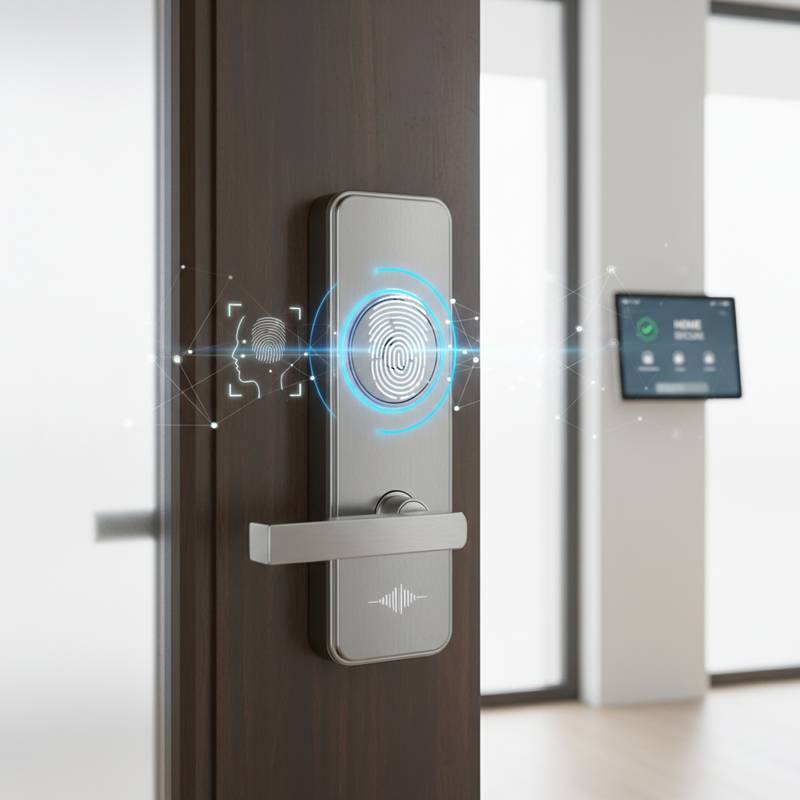Biometrics Beat Hacks: The Future of Smart Door Locks
Smart homes evolve rapidly, and one of the most significant changes occurs at the front door. Traditional keys recede as digital access methods emerge, promising superior security and ease of use. Biometric door locks lead this shift. These devices open with a touch or glance, transforming the sense of safety within the home.
From Codes to Confidence
Smart locks once depended on PINs, Bluetooth pairings, or mobile applications. Such systems offered convenience but exposed vulnerabilities. Lost devices, shared codes, and replicated credentials rendered them as susceptible as physical keys. Biometric smart locks alter this dynamic by employing unique personal traits. Fingerprints, facial features, or voice patterns serve as the access method. Each use proves personal, secure, and resistant to imitation.
Research from smart home analysts indicates that homeowners favor biometric options. A substantial number of recent purchasers highlight enhanced trust and dependable identity checks as primary motivations. This preference reflects a broader movement. Individuals seek security that operates seamlessly while remaining robust.
Why Biometrics Resist Hacking
Biometric authentication examines distinctive physical characteristics. Fingerprint scanners identify unique ridge and valley formations. Facial recognition employs depth sensors and infrared technology to verify identity under varied lighting conditions. Voice systems analyze tonal nuances and phonetic patterns. These elements defy prediction or replication, unlike passwords that hackers can steal or guess.
A key strength lies in localized processing. Numerous biometric locks encrypt and store data on the device itself, bypassing cloud reliance. Network intrusions thus fail to access personal templates. This self-contained design minimizes risks and bolsters reliability.
Security specialists emphasize the identity-first principle in biometric locks. Verification targets the individual rather than a code or gadget. This fundamental change redefines protective measures.
Everyday Simplicity
Biometric locks excel in practical scenarios beyond their technical merits. They eliminate routine frustrations. Carrying groceries no longer involves searching for keys. Family members avoid memorizing codes that might slip their minds. A brief touch, look, or spoken word suffices for entry.
Consider returning home laden with parcels. The lock identifies you upon approach and disengages smoothly. Interior lights activate, and the thermostat shifts to your preferred level. Such integration blends security with daily comfort, creating an intuitive experience.
Leading manufacturers like Ultraloq, Lockly, and Eufy showcase advanced capabilities. Certain models pair fingerprint scanning with voice assistants and broader home networks, coordinating with lights and cameras. This harmony renders protection unobtrusive.
The Trust Factor
Effective security extends beyond barring entry; it fosters assurance. Biometric locks instill confidence through direct, visible identity confirmation. Users witness the process each time they engage the sensor or observe a relative gain access.
Accuracy advancements build further reliability. Initial versions faltered with damp fingers or dim environments. Contemporary units apply multi-factor analysis and machine learning to adapt. They account for minor changes in pressure or appearance, minimizing errors and refining performance over repeated uses.
Privacy demands careful handling, and producers address this proactively. Prominent models feature device-level encryption, on-site data retention, and options to limit external sharing. These safeguards preserve user information, supporting sustained adoption.
Integration with the Smart Home
Biometric locks function as gateways to broader automation. Upon recognition, they initiate tailored home adjustments. Illumination sets to individual preferences, audio systems engage quietly, and heating or cooling aligns with accustomed settings.
Seamless connectivity requires compatible protocols. Emerging standards like Matter enable cross-brand harmony. Secure data exchange among locks, climate controls, and fixtures creates an environment attuned to occupants.
Market observers report rising expectations for such cohesion. Isolated gadgets give way to unified systems that anticipate user needs intelligently.
Barriers and Breakthroughs
Biometric locks encounter hurdles despite their benefits. Initial costs exceed those of basic smart alternatives, though economies of scale lower prices. Concerns over sensor consistency or information handling persist. Clear guidance and open practices mitigate these issues.
Developers prioritize resilient components, all-weather construction, and fortified privacy protocols. Hybrid models incorporate layered verification, such as fingerprints alongside app confirmation, enhancing defense without complicating use. These options attract diverse users, from innovators to the prudent.
Sales data shows accelerating uptake as installation simplifies and compatibility expands. What began as premium features now qualifies as standard improvements.
A Glimpse at What’s Next
Future biometric locks may incorporate expanded identifiers. Heart rate monitoring, walking patterns, or habitual behaviors could enhance verification. Experimental designs leverage algorithms to detect approach signatures, preemptively unlocking for authorized individuals.
Evolution prioritizes usability alongside discretion. Users desire intuitive tools free from overreach. Optimal innovations integrate subtly, emphasizing on-device data management for privacy.
Embracing Effortless Entry
Adopting a biometric lock marks a transition to streamlined protection. Relief from key losses or code lapses personalizes the living space. Interactions rely on natural actions rather than mechanical ones.
Those interested in this upgrade should begin modestly. Install a fingerprint-equipped deadbolt on the primary entrance or a face-scanning unit for a workspace. Select devices compatible with current setups and featuring local storage. The practical advantages emerge quickly, justifying the choice.
